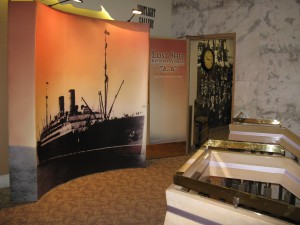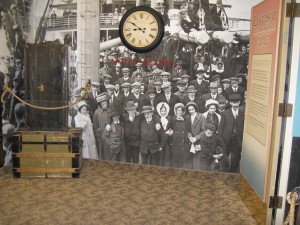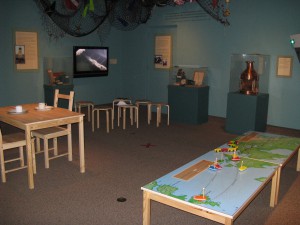Limited Visibility (2nd Probe)
To: Darren Werschler
From: Aline Lemay
Posted September 24, 2014
Cultural Objects:
“Lost Ship, Recovered Voyages: Empress of Ireland”
Exhibition at the Royal Alberta Museum, Edmonton, 2008
Royal Alberta Museum online exhibit: “Lost Ship, Recovered Voyages: Empress of Ireland”, 2013
Images:
Empress entrance
Empress entrance clock
Empress map with video
________________________________________________________________
“The story of the Titanic was bad enough…but with the Empress of Ireland, it was different… alas! No science and no skill could dodge that death which lumbered up through the night.”
Mr. Gibbs in The Graphic, June 6, 1914
My probe for “Form and Cultural Technique” examines the development of an exhibition entitled, “Lost Ship, Recovered Voyages: Empress of Ireland” (2008) at the museum, and compares it with the exhibition as posted online; I don’t know the exact timing. How do the text and media choices – inclusions and omissions – shape the experience of this shipwreck, within a museum and online? The entrance panel for the exhibition:
Lost Ship, Recovered Voyages
On the night of May 29, 1914, the eastbound Empress of Ireland collided with the Norwegian collier the Storstad. In the cold waters of the St. Lawrence, 1,012 people from the Empress drowned – comparable to the Titanic losses two years earlier. But the largest Canadian Maritime disaster was quickly forgotten with the start of the First World War.
This elegant ship was lost in only 14 minutes. But the voyages of the Empress of Ireland are being recovered through remnants of the ship and her stories. This gallery celebrates those who immigrated to Western Canada by ship and rail almost a century ago, and honours those who were lost.
Note the time on the wall clock before entering the gallery. Think about how quickly 14 minutes passes. Only 465 people made it out of the Empress in time.
One exhibition, two forms
In the museum, it was presented as a journey. The online version of the exhibition captures its essence: lists of headings and subheadings, with links leading to text and images.
Royal Alberta Museum: Lost Ship, Recovered Voyages: The Empress of Ireland
1. Boarding the Ship: Promotion materials such as “Canadian Pacific” and “Last Best West” poster, the latter showing the promise, “Own you own home in Canada and apply for a ready-made farm”.
2. Shipboard Experience:
a. “Shipboard Class” shows photographs of First, Second and Third Class Dining rooms. In the exhibition, a table was set with the salvaged artefacts, including bottles of barnacle-covered champagne, wine, and beer. The decision to not include these online may have been the desire to maintain a neat look appearance?
b. “Behind the Scenes” included images and artefacts from the kitchens, and the Marconi Navy phone. Each section of the exhibition included a quote on the wall, in large type. These are not part of the online presentation. “Well, you go in there and find a young man all surrounded by most wonderful telegraph instrument which buzz and click and spit out long blue sparks”. Rudyard Kipling describing “The Wireless Shack”.
c. “Ship Safety”
d. ‘La Belle Vie’
3. Building a Life in Alberta: text and images illustrate difficulties of the newcomer experience
4. The Wreck: includes the created image of the Empress and Storstad collision. Within the exhibition, visitors could try a navigation exercise to avoid a collision, using only the other ship’s lights to go left or right. The recreation of this as an online game is an example of a digital ‘bonus’. The activity text in the exhibit didn’t work so well for two steam ships meeting and passing: “When both side-lights you see ahead – Port you helm and show your RED. GREEN to GREEN – or, RED to RED – Perfect safety – go ahead!” – the “Rule of the Road at Sea” by Thomas Gray, 1867.
5. Respecting the Wreck: diving the wreck. Text concludes with, ‘Six divers have lost their lives’.
6. Protecting the Empress: preservation of the site in the exhibition included this quote:
“If Canadians may not ransack graveyards looking for valuables, why may they pick through the bones of those drowned in a tragic shipwreck for the same purpose?
– Underwater grave should be protected,” Edmonton Journal, 23 April 1998
Other than the quotes, the online version does not offer these two features of the exhibition:
1. Sound and light experiences: At the beginning of the exhibit, there was an audio loop of the sound of the ocean, waves, splashing, seagulls and a steamship’s horn. A gobo projected blue waves on the walls.
2. Segments of the video “Journey to Oblivion: The Empress of Ireland Story” played in the “Respecting the Wreck” section.
National Film Board of Canada, Merlin Films, 2001 – Video trailer (2:25)
Views of the luxurious ship before the final voyage were juxtaposed with the ship underwater. The ‘before’ and ‘after’ effect required neither text nor audio. The NFB video is available for purchase.
A list of the passengers’ names was posted at the end of the exhibition. Four hundred and sixty five names were followed by (rescued). The complete list of the passengers and crew members is available online under “The Wreck”.
Four readings
1. “Near Print and Beyond Paper: Knowing by *.PDF”
My impression from reading the Gitelman article was that it was older, but it is 2014. She describes the text, illustration and photography paper trails of the advertising and marketing worlds, with the example of newspaper television promotions. She continues to the fixity of print, then to digital documents, focusing on the PDF. Although I appreciated her description of the realities of the portable document format, I wondered if it wasn’t disconnected from the context of exhibition development. PDF’s are of limited use to a development team, and mostly unnecessary if the team members are located in close proximity for meetings. Curators and interpretive planners use programs like Microsoft Word and Excel for writing and editing text and artefact lists. These documents are shared with exhibition and graphic designers, who use programs like Adobe Photoshop, Adobe Illustrator, SketchUp, Rhinoceros 3D, AutoCAD and other 3D modeling software to place collection and media within the design of the exhibition space. Print-outs and screenshots of what the design team produces are necessary for review, and testing visibility within the context of the exhibition. PDFs can serve to share manuals, government documents and white papers, yes, but the curator may be the only person who needs to consult this information, electronically, if necessary. The museum’s design team may create PDF’s to distribute educational and marketing images, video and text, but resolution must always be high for images and videos. I am not able, within my own limited and dated technical knowledge, to clearly identify the use of PDFs within my probe. Searchability is a key practical consideration in the exhibition development process. I appreciated her conclusion: “So the document persists…the authority of the document, on the one hand, and the authority of specific systems and bureaucracies, on the other hand” (Gitelman 135).
2. “Culture, Technology, Cultural Techniques – Moving Beyond Text”
What I found of particular interest about form and cultural technique in Kramer and Bredekamp article was the following:
“Culture is no longer a matter of monolithic immobility congealed in works, documents or monuments, but liquefies into our everyday practices with objects, symbols, instruments and machines. The right of exclusivity, which language used to claim for itself (with regard to representing culture), is no longer unchallenged. It is in the (inter)play with language, images, writing, and machines – in the reciprocity between the symbolic and the technical, between discourse and the iconic – that cultures emerge and reproduce.” (Kramer and Bredekamp 24)
But tasks must be clearly delineated – let curators write, designers design. The computer’s intervention is this is clear:
“The computer regulates almost all productive processes; it coordinates the social communication of our society and intervenes in the production of knowledge. It manages all that precisely by having fully permeated the routines and practices of our everyday world. (Kramer and Bredekamp 24)
The conclusion of their recapitulation of the article, Kramer and Bredekamp note the following: “… e) the media innovations accruing in the wake of changing cultural techniques are located in a reciprocity of print and image, sound and number, which, in turn; (f) opens up new exploratory spaces for perception, communication, and cognition; and (g) these exploratory spaces come into view where disciplinary boundaries become permeable and lay bare phenomena and relationships whose profile precisely does not coincide with the boundaries of specific disciplines.” (Kramer and Bredekamp 27). Clear boundaries between the disciplines are essential to a healthy museum exhibition development process, but a mutually agreed-upon vision to prioritize and delineate tasks, moves the form toward a balance of media, objects, images, video, and text to create a unified whole.
3. “Afterword: Cultural Techniques and Media Studies”
“In these afterwords I will focus on connectivity rather than genealogy… As mentioned at the very beginning of the introduction, this issue itself is meant to be both an archive and a toolbox…” (Parikka 148). His analogy of the toolbox is key to exhibition development. Available tricks and tools yield potential solutions. When I was developing the Empress of Ireland exhibition, I saw an online mention of the video Sombre dans l’oubli, by Merlin films. I called and inquired – in French – about being able to show “Journey to Oblivion: The Empress of Ireland Story” in the exhibition at the Royal Alberta Museum. I don’t remember if I spoke with the director or the producer but I was told they would be pleased, as long as they are mentioned in the credits. Is ths integration of the video into the gallery’s storyline an example of this blurring? “In media-oriented cultural techniques there is a persistent interest in the materiality of the world, in which media relate ‘to ontological and aesthetic operations that process distinctions (and the blurring of distinctions) which are basic to the sense production of any specific culture’ (Siegert, 2011: 14, quoted in Parikka 153). Given the historical content of the exhibition about the Empress, I revisited the exhibition storyline to look at how media practices shaped it. “Cultural, aesthetic and mediatic operations are approached as historically situated. This also means that textuality is not discarded as an analytical approach but refined in relation to its material conditions” (Parikka 153).
4. “News Form and the Media Environment: A Network of Represented Relationships”
“The form of news has as much to do with its work in the world as its content does”, wrote Nerone and Barnhurst (p 111). Both the form and the cultural techniques determine its ‘work in the world’ in exhibitions. Environment is an important consideration. “Besides understanding communication as a plumbing system carrying messages from senders to receivers (the transmission model), and as a daily reaffirming of community ties (the ritual model), we find it useful to think of the news as an environment. The newspaper environment sets up a panorama of distant events and invisible forces (what environmentalists call an exosystem, Bronfenbrenner, 1979), and readers feel empowered because otherwise inaccessible places come within their reach” (Nerone and Barnhurst 112). I wondered it ‘museum visitors’ could replace ‘readers’ in that sentence. “media also work to enable groups of people to live together as a community (if not actually, then at least in their imaginations)” (Nerone and Barnhurst 112).
Those who develop museum exhibitions share this: “Our big question became: ‘How does the form of news enable or disable civic culture?’ By civic culture we have a utopian notion in mind, combining critical deliberation and multicultural recognition – a culture where news makes people smarter and more active politically, and where people get a fair shake” (Nerone and Barnhurst 114).
Based on what I’ve seen in the online presence on many museums, there is a move toward the metaphor of the coffeehouse or the town meeting, for “citizens who would be persuaded by facts and strong arguments and would be discerning about falsity and fallacy. Both presumed the power of truth to candid minds” (Nerone and Barnhurst 117). In trying to place a visit to a museum exhibition within these contexts, the experience varies from solitary to shared. Although online exhibitions allow the content to travel, the manners in which digital media may offer the advantages of a shared communal experience remain a work in progress.
Works cited:
Gitelman, Lisa. “Near Print and Beyond Paper: Knowing by *.PDF.” Paper Knowledge: Toward A Media History of Documents. Durham/London: Duke University Press, 2014. 111-35.
Krämer, Sybille, and Horst Bredekamp. “Culture, Technology, Cultural Techniques – Moving Beyond Text.” Theory, Culture & Society 30.6 (2013): 20-29.
Nerone, John, and Kevin Barnhurst. “News Form and the Media Environment: A Network of Represented Relationships.” Media Culture Society 25 (2003): 111-24.
Parikka, Jussi. “Afterword: Cultural Techniques and Media Studies.” Theory, Culture & Society 30.6 (2013): 147-59.



